Vertical gardening means growing plants on an upright support such as a stake, trellis, cage, net, or fence.
Beans, tomatoes, cucumbers, melons, squash, and pumpkins—nearly all vining and rambling crops—can be grown on vertical supports. Some studies say that the yield per square foot for vine crops can be doubled by growing them vertically.
Many vining crops will climb vertically by themselves using twisting tendrils to grasp the support. Others may require twist ties or string to help them grow up.
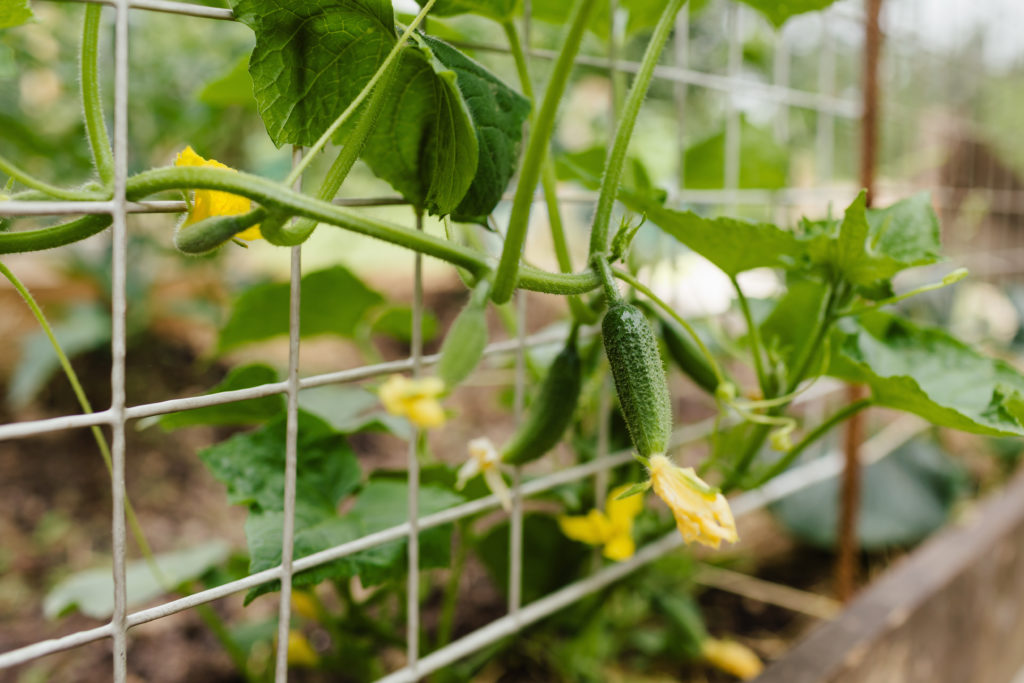
Reasons to grow vertically
• Save space. Vertical vegetable gardening saves space. Cucumbers, melons, pumpkins, and squash require much ground space. One untrained cantaloupe will crawl over an area of 16 square feet. The same melon trained vertically will take only one or two square feet of ground.
• Avoid pests and diseases. Slugs, snails, and other pests can quickly attack crops growing on the ground; it is much more difficult for them to climb trellises or strings. Crops growing on the ground come in contact with wet soil which can cause rot or disease.
• Fruit appearance. The fruit of cucumbers and squash grown vertically hang down and grow straight with the pull of gravity. Fruits will grow longer and straighter.
• Protection and garden beauty. Vertically growing vegetables leaf out across the support. Masses of leaves protect ripening vegetables from sun and windburn. A leafy trellis or fence can shield the garden from prevailing breezes and block out unwanted views—of neighboring property or compost piles.
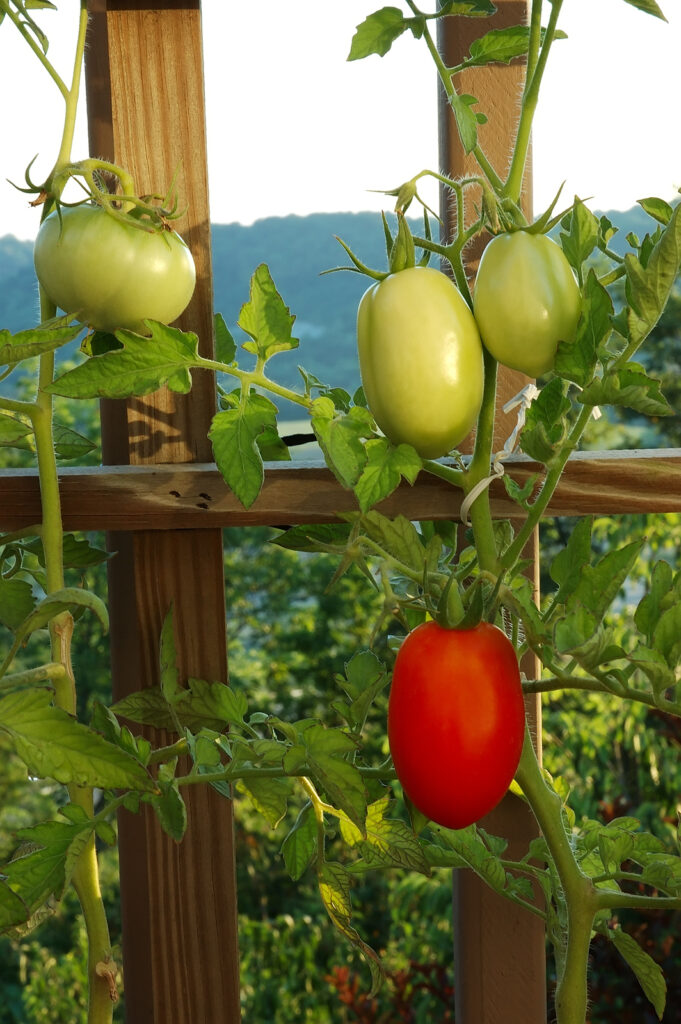
Where to grow vegetables vertically
Vegetables can be grown on vertical supports wherever they can get full sun. A vertical vegetable garden can be located in a yard, on a patio, on a balcony, or on a rooftop. Grow vegetables vertically where they will not shade other crops. Place vertical supports at the north end of the garden where crops growing upward will not shade other crops.
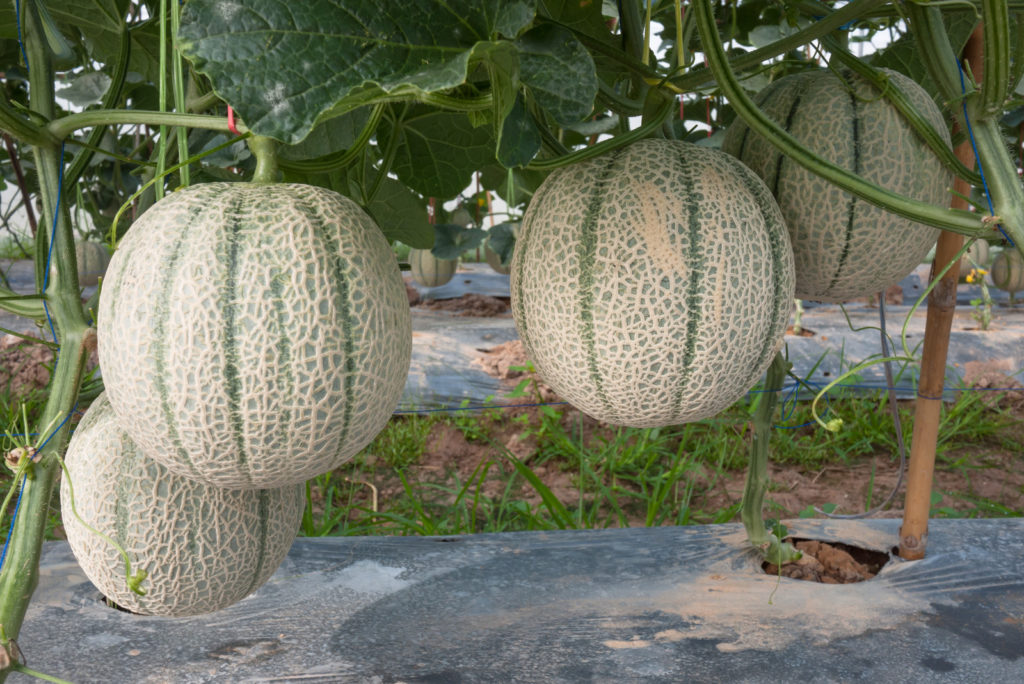
Crops for vertical growing
Here are vegetables that can easily be grown vertically:
Beans: pole beans produce throughout the season (bush beans mature all at once, and then stop).
Cucumbers: All varieties of cucumbers can be grown vertically. You can prune cucumbers to a single stem or prune them to the branches growing toward the vertical support. Cucumbers grown vertically will grow longer and straighter.
Melons: All melons can be grown vertically (except watermelons) without support for the fruit. Be sure to pick ripe melons before they slip from the stem. Melons also can be attached to the support with a net or sling.
Peas: Peas are a spring crop. Space them just 2 inches apart and train them up chicken wire or a fence. When the vines dry up, replace them with beans or squash, or any other vine crop.
Summer squash: Summer squash will form fruit along the length of the vine when grown vertically. Tie summer squash in at about 1-foot lengths.
Winter squash: All winter squash can be grown vertically without support for the fruit, except the large and heavy Hubbard and Banana squash.
Tomatoes: Indeterminate or vining tomatoes that keep growing long from the tip of the vine (unlike determinate or bush tomatoes) will grow on any vertical structure including strings. Tomatoes are commonly grown vertically in cages or on poles.
Types of vertical supports
- Trellis, netting, or fence
- Wire or wooden cages
- Teepees and tripods
- A-frames
- Poles and posts
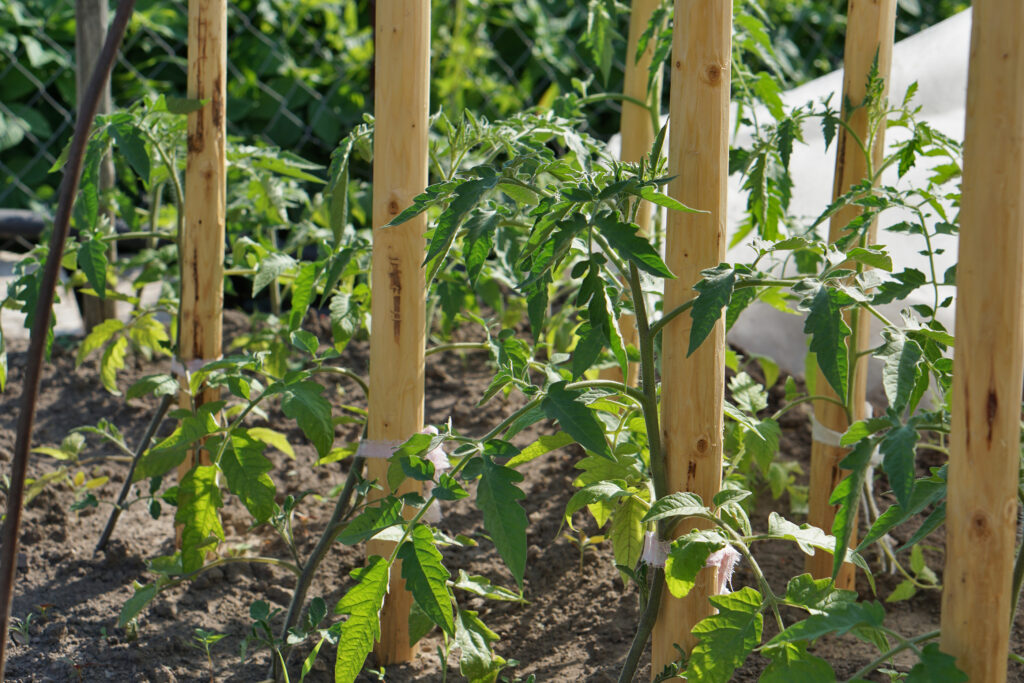
Poles and posts
Vining crops can be trained to single poles or posts—like tomatoes pruned to a single leader or stem. Or poles and posts can be used to support horizontal wires, ribbons, twine, wire mesh, or netting. Place an X-frame or umbrella-frame at the top of the post, drive nails into the post, and run string or wires between the top and bottom of the post; plant beans or cucumbers in a circle around the post and train the vines up the strings.
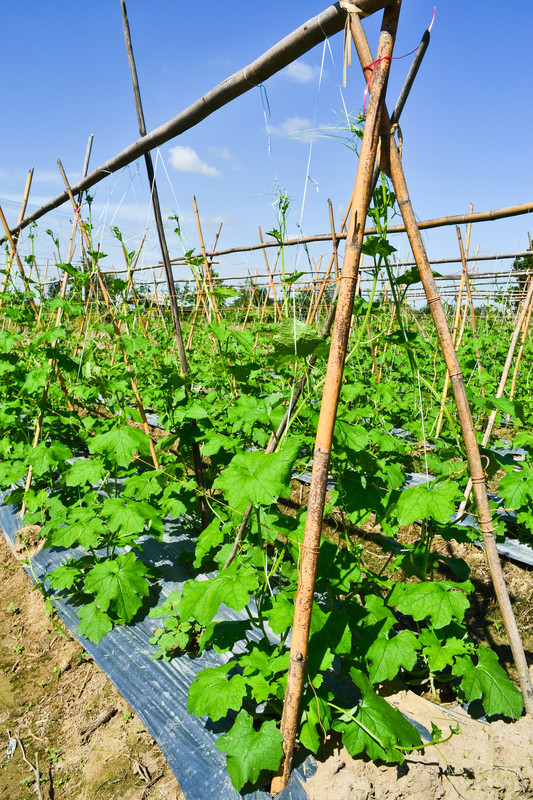
A-frame
A-frames can be made from 1-by-1s, 1-by-2s, 2-by-2s, or bamboo poles. You can make an A-frame at any height. You can design an A-frame to fit into any space. Make the A-frame portable by adding hinges at the top and you can move around the garden from year to year and store it easily. You can cover the frame with chicken wire or leave it slated. Set it facing east and west and plant beans on one side and cucumbers on the other. And you can intercrop the space beneath the frame with onions, leaf lettuce, radishes, or turnips; harvest the lower crop before the vines shade them.
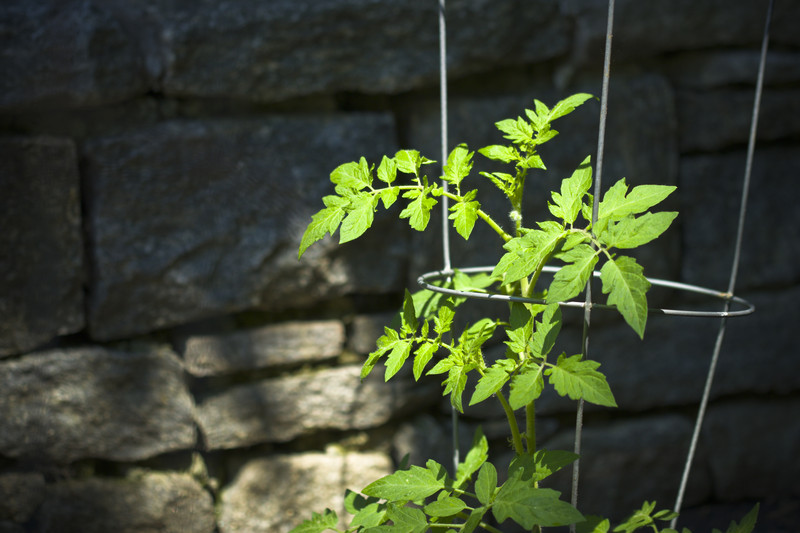
Wire cage
Wire cages can be used for tomatoes, cucumbers, peppers, and zucchini. Cages allow you to get a maximum number of plants into a small space—keeping fruit and foliage off the ground clean and rot-free. Use cages 4 to 6 feet tall for indeterminate tomatoes; use shorter cages 3 to 4 feet tall for cucumbers and bush varieties of melon, pumpkin, and winter squash. You can set six cucumber plants around a 3- to 4-foot-high, 19- to 24-inch-diameter wire cage—plant in a horseshoe shape to allow easy access to fruits on the inside of the cage.
You can make cages out of 4-inch or 6-inch-mesh concrete-reinforcing wire—or choose a lighter galvanized fence wire if the mesh is too stiff. Choose a mesh wide enough to put your hand through so that you can remove the fruit at harvest, or cut a hole on one side of the cage. Be sure to drive wooden or metal garden stakes about 6 inches into the ground and wire them to the cage for extra support.
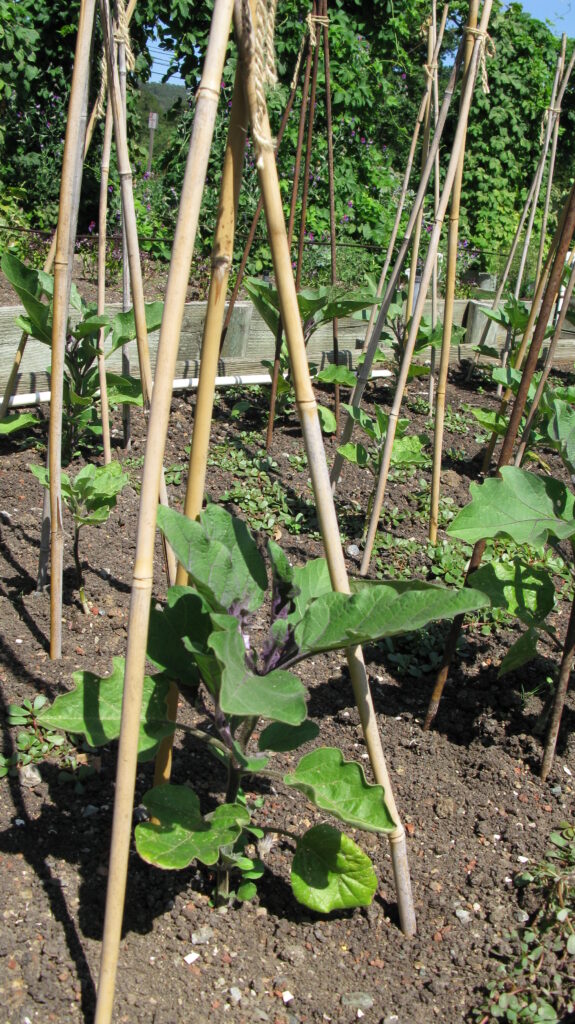
Tripods
Tripods (three-legged frames) and quadrupeds (four-legged frames) are easy to make and keep vines off the ground—pole beans, runner beans, and limas. They are easy to move and can be taken down in minutes for winter storage. Make the legs from an 8-foot length of 1-by-2 lumber. You can hinge the tripods at the top.
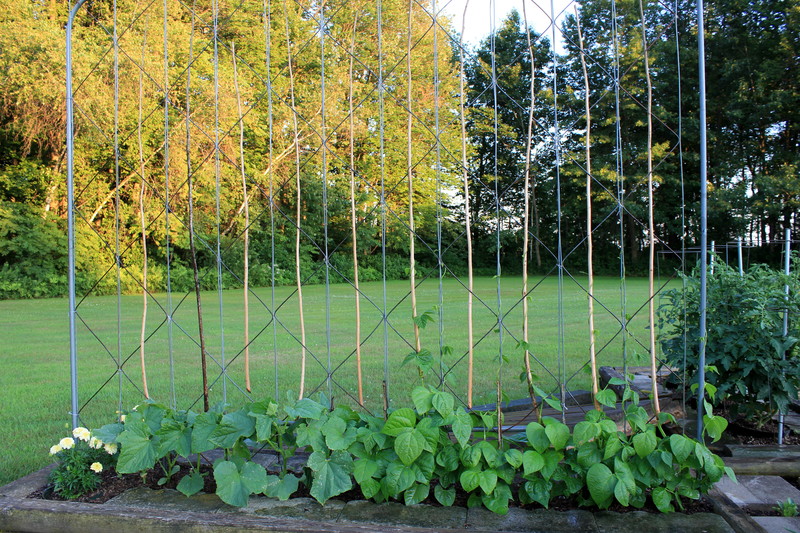
Frame for net or vertical cords
This frame extends upward at least 6 to 8 feet. It can be made out of 2-by-4s, iron pipe, or electrical conduit. You can stretch a 1-inch to 4-inch mesh netting or chicken wire across the support to give vines something to cling to. You can also stretch lines of field wire (standard fencing wire used by ranchers) or garden twine from top to bottom to train vines up single cords. You can use the back support to support rectangular wood trellises.
Related articles:
Small Vegetable Garden Space Savers
Garden Planning Books at Amazon:
- Vegetable Garden Almanac & Planner
- Kitchen Garden Grower’s Guide Vegetable Encyclopedia
- Vegetable Garden Grower’s Guide
- Tomato Grower’s Answer Book















